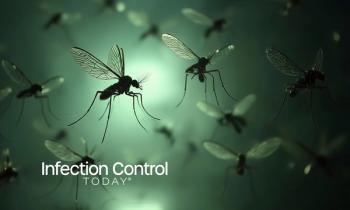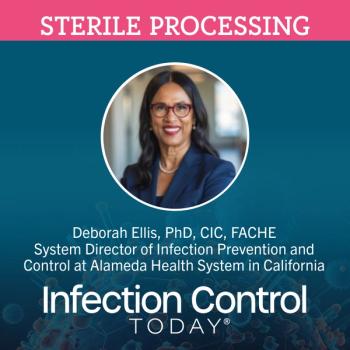
- Infection Control Today, April 2023, (Vol. 27, No. 3)
- Volume 27
- Issue 3
Water Management and IP Risk
Numerous pathogen outbreaks have been from the water in medical facilities. So what are the dangers, and what can infection preventionists do to prevent morbidities and mortalities from occurring?
Water, sanitation, and hygiene in health care facilities are fundamental to safe patient care. The water management infrastructure impacts many aspects of health care, from hand hygiene, food and nutrition services, and sterile processing to humidity levels in procedural spaces. The environment of care is a large aspect of a successful infection prevention (IP) program. Water management and quality is a foundational piece of that infrastructure that has many far-reaching elements for an infection preventionist to understand.
Water is a prime environment for bacterial growth, which can contribute to the contamination of surfaces and create reservoirs for pathogens. As health care becomes more complex, water remains a key source to consider when investigating unusual clusters of health care–associated infections. It is a potential source of pathogens not only in a facility’s piping and plumbing but also for the medical devices and instruments used to treat patients.
Compared with the general population, patients and residents in health care facilities may be more at risk of developing infections after exposure to waterborne pathogens because of immunosuppression and the bypassing of natural protective barriers by invasive medical devices, for example. Additionally, biofilms can be challenging to remove during routine cleaning or disinfection and therefore become a propagated source of exposure. Patients can be exposed to waterborne pathogens through a variety of transmission pathways: indirect or direct contact, inhalation of aerosolized particulates, and ingestion or aspiration of contaminated water.1
Data from studies of health care– associated infections or outbreaks associated with environmental exposures to pathogens through water sources have revealed numerous reservoirs, including sinks, faucet aerators, showers, ice machines, dialysis machines, eye wash stations, and immersion tubs.2 Legionella has been associated with outbreaks in health care facilities linked to decorative fountains, immersion tubs, ice machines, and other hospital water systems.2 Multidrug-resistant (MDR) gram-negative pathogens, such as MDR Pseudomonas aeruginosa and Klebsiella oxytoca, have been linked to outbreaks associated with hospital wastewater systems in sinks and toilets, as well as faucet aerators in handwashing sinks.2 Numerous outbreaks have involved nontubercular mycobacterium (NTM) from various sources, in particular heater-cooler units used in cardiac surgery.2 All these examples, and many more, have caused significant patient morbidity and mortality.
Infection preventionists perform routine surveillance to help identify clusters associated with a waterborne outbreak. Partnership with local public health departments also amplifies the ability to investigate, test, and identify the source of these types of outbreaks. The result is the implementation of controls to stop the outbreak, and, ultimately, the sharing of information that results in changes to practices, systems, and policies to prevent similar outbreaks from occurring in the future.
Cleaning and disinfection of water sources, such as chillers or boilers used in heating, ventilation, and air-handling units, is under the direction of the facility engineering department of an organization. Also, building codes and construction guidelines will specify certain aspects related to water systems to help decrease the risk of contamination. For example, there are specifications for sink depths and faucet placement to decrease the risk of splashing onto counter surfaces and potential contamination of patient care supplies or medications with pathogens.3
Typically, the cleaning and disinfection of medical equipment is handled by a biomedical engineering department or sometimes the end users of the equipment in their departments. In these cases, strict adherence to the manufacturer’s instructions for use (IFU) is required. Routine audits of processes of high-risk medical equipment, such as hemodialysis machines, heaters/ coolers for perfusion, and endoscopes, help ensure that staff are following appropriate IFUs. Staff who perform cleaning and disinfection should have current training and competencies. Additionally, infection preventionists should also participate in local supply chain value analysis or products teams to ensure that any new equipment being proposed has cleaning and disinfection IFUs and that teams are aware of what those requirements are, as well as whether those instructions are feasible with the limits on staffing, time, and space in health care facilities.
Construction activities also can be a threat to maintaining a safe water supply. When reviewing an infection control risk assessment for a construction project, it is essential that the infection preventionist understand the impact on water sources in the surrounding locations. If water shut-offs are required, alternative sources for handwashing, food preparation, and other patient care activities need to be identified. Also, if plumbing activities are within the scope of the project, consideration must be made to decrease the risk of dead-end pipes and areas where stagnant water can sit. Upon completion of the project, water flow needs to be returned, and flushing of pipes and any cleaning or disinfection of the system will be part of the terminal cleaning and check-off for project closeout. Additionally, infection preventionists need to be involved from the beginning of new construction or renovation projects to ensure sink placement, surface elements, and other water system considerations are addressed early in the design phases. Similarly, they can offer insight into reasons to avoid designing water displays in health care facilities because of the increased risk of exposure to vulnerable patients.
Another area where water quality is essential is within sterile processing departments. Sterile processing, including high-level disinfection of endoscopes, is a high-risk department in health care facilities. Sterile processing staff and leadership need to understand how local water quality can affect the cleaning, disinfection, and sterilization processes of medical instruments. Not only can water quality have an effect on the instruments themselves, such as pitting and endotoxin bioburden, it can also affect the equipment and chemicals used during the processing.4 National regulatory bodies require the testing and treatment of water that is used in sterile processing departments, including verifying levels of bacteria and endotoxins. Infection preventionists should understand these requirements and how local water systems can impact sterile instrument processing.
Because of continued patient safety concerns with pathogens being transmitted via water sources, the CDC recommends that IP programs develop water management programs as a preventive measure to reduce health care– associated infections.3 A toolkit is available to help infection preventionists create the framework for the water management program and ensure the key pathogens are addressed, including Legionella, gram-negative organisms, and NTM.
Although the CDC is not a regulatory body and can only make recommendations, other national bodies have included water management as a requirement for health care facilities, including the Centers for Medicare & Medicaid Administration (CMS) and The Joint Commission (TJC). CMS requires health care facilities to develop water management programs that are compliant with American Society of Heating, Refrigerating and Air- Conditioning Engineers guidelines.5
TJC recently updated their standards for health care facilities’ water management programs. Starting in January 2022, TJC standards expand on prior expectations that included risk assessments, a water management plan, and testing guidelines to include identified oversight of the program and more specific elements of processing steps, diagrams, and maps of the water system.6 Infection preventionists are expected to be coauthors of these water management programs, in particular creating risk assessments associated with the types of patients and activities at the health care facility and potential exposures to waterborne pathogens.
Water management safety and quality is a complicated and multifaceted aspect of an IP program. Infection preventionists are not subject matter experts when it comes to the daily workings of a facility’s plumbing and water processes, but they are crucial in helping determine risks associated with contamination or subpar maintenance to patient outcomes and helping determine the potential source of an outbreak associated with water systems. Collaboration with facilities, sterile processing and bioengineering departments, and hospital leadership is essential to a successful program.
References
- Yiek WK, Coenen O, Nillesen M, van Ingen J, Bowles E, Tostman A. Outbreaks of healthcare-associated infections linked to water-containing hospital equipment: a literature review. Antimicrob Resist Infect Control. 2021;10(1):77. doi:10.1186/s13756-021-00935-6
- Healthcare outbreaks associated with a water reservoir and infection prevention strategies.Kanamori H, Weber DJ, Rutala WA. Clin Infect Dis. 2016;62(11):1423-1435. doi:10.1093/cid/ciw122
- Reduce risk from water. CDC. Updated September 11, 2019. Accessed February 11, 2023.
https://www.cdc.gov/hai/prevent/environment/water.html - AAMI TIR34 – Water for the reprocessing of medical devices. Evoqua Water Technologies. Accessed February 16, 2023.
https://www.evoqua.com/en/articles/AAMI-TIR34-water-for-medical-devices/ - Federal requirement to reduce Legionella risk. CDC. Updated March 25, 2021. Accessed February 11, 2023.
https://www.cdc.gov/legionella/wmp/healthcare-facilities/federal-requirement.html - The Joint Commission. New standard for water management program – hospitals, critical access hospitals, and nursing care centers. R3 Report. 2021;32:1-5. Accessed February 11, 2023.
https://www.jointcommission.org/-/media/tjc/documents/standards/r3-reports/r3-report-water-management-final_nov1.pdf#:~:text=The%20Joint%20Commission%20evaluated%20expert%20literature%20to%20determine,management%20program%20and%20when%20any%20changes%20have%20occurred
Articles in this issue
over 2 years ago
Bug of the Month: Highly Contagious But Not Deadlyover 2 years ago
Encouraging Professional Development of IPs and Epidemiologistsover 2 years ago
The Metric Every IP Should Have on Their Work Plan in 2023Newsletter
Stay prepared and protected with Infection Control Today's newsletter, delivering essential updates, best practices, and expert insights for infection preventionists.




